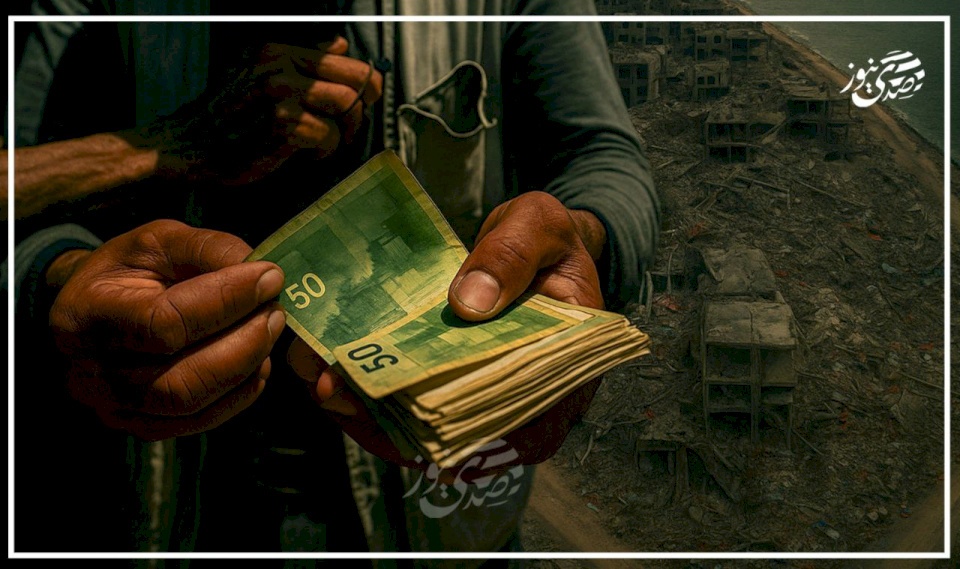
Where did the 180 million dollars stolen from banks in the Gaza Strip go?
Customer deposits in Gaza increased by 204% over two years of war
Exclusive to SadaNews - Since the outbreak of war against the Palestinian people in the Gaza Strip, violations have not only been limited to lives and property but have also extended to financial institutions, which represent a vital artery for the national economy. The banks operating in the sector have been subjected to organized looting carried out by armed groups and occupying forces, in an attempt to undermine one of the key pillars of economic stability.
In repeated statements, the Palestinian Monetary Authority clarified that the volume of money looted from bank vaults in Gaza has reached about (180) million dollars, a figure that highlights the seriousness of these assaults and raises fundamental questions about the fate of that money and the potential implications for the future of the Palestinian economy.
Deputy Governor of the Palestinian Monetary Authority Muhammad Manasra confirmed to "SadaNews" that the issue of the money looted from banks in the Gaza Strip has since been handled by the government and is no longer under the supervision of the Monetary Authority.
He added: "This issue has been reflected in banking figures by requesting banks to allocate financial provisions to address those losses from the looted money," noting that these funds have already been deducted from the banks' profits recorded last year.
According to data issued by the Palestinian Banking Association, financial reports indicated that banks recorded their lowest levels of profits by the end of 2024, with total profits for that year only reaching 43.5 million dollars, down from 168.1 million dollars in 2023. The highest profit rate recorded by banks was in 2022, reaching 227.9 million dollars.
Manasra had previously stated that the money available in the bank vaults in the Gaza Strip before the war amounted to about (290) million dollars, indicating that about (180) million dollars of that was looted.
Le Monde newspaper reported last year that armed groups stole up to (66) million euros in April from branches of a bank operating in the Gaza Strip.
The newspaper stated that it had reviewed a document sent by the bank "to international partners," describing qualitative robbery operations, including one targeting its main branch in the city of Gaza.
Governor of the Monetary Authority Yahya Al-Shanar indicated during a meeting with journalists that the banking sector had not resumed usual banking operations in the Gaza Strip, which involve injecting cash liquidity into the markets for three reasons: first, the vaults of banks and ATMs were destroyed due to the war; second, the Israeli side's refusal to allow cash inflow operations; and third, the lack of security stability within the Gaza Strip, which led to the looting of (180) million dollars from bank vaults during the war.
He confirmed that resuming normal banking operations requires rebuilding many bank buildings, ATMs, and vaults, noting the importance of ensuring necessary security guarantees to prevent banks from being subjected to further looting.
The Palestinian Monetary Authority directed in mid-October last year for banks operating in the Gaza Strip to begin providing financial and banking services to the public according to their technical and operational readiness.
It confirmed that "the process of reopening banking branches will be gradual and phased, with a limited number of branches operated in the first phase according to their readiness, while other branches to be put into service will be announced subsequently according to rehabilitation plans."
It urged the public to "continue to rely on available electronic payment methods, such as payment cards, electronic wallets, and banking applications via smartphones, given the ease, security, and speed they provide in completing transactions, ensuring their needs are met without having to crowd at branches."
Despite this, observers believe that the resumption of some banks' operations in the Gaza Strip has remained largely superficial, due to their inability to complete deposit and cash withdrawal transactions.
Recent figures released by the Monetary Authority showed that the volume of customer deposits in the Gaza Strip rose to about 4.91 billion dollars by the end of last year, compared to 1.61 billion dollars during the same period in 2023, indicating that the volume of deposits in the Gaza Strip increased by 3.26 billion dollars, a rate of 204%.
Experts attribute this significant rise to the destruction inflicted on various economic sectors in the Gaza Strip due to the war, which prompted business owners to place their money in banks as deposits.
The World Bank had previously stated that the aggression on the Gaza Strip led to the destruction of about 93% of the branches of banks operating in the sector.
The report indicated that the Israeli war also destroyed 88% of microfinance institutions and most currency exchangers, and 88% of insurance companies.
Today, only 3 out of 94 ATMs across the Gaza Strip are operational, according to matching data from the World Bank and the Monetary Authority.
There were (10) banks operating in the Gaza Strip out of a total of (13) local and foreign banks operating in the Palestinian market.

Presidency: The National Economic Empowerment Institution is the sole authority responsibl...

Netanyahu: Our opposition to the establishment of a Palestinian state on any land has not...

The Death Toll from the Aggression on Gaza Rises to 69,483 Martyrs

Transmitted Through Intermediaries: List of Prisoners from Gaza in Occupation Jails

Where did the 180 million dollars stolen from banks in the Gaza Strip go?

UN Draft Opens the Door for a Palestinian State, While Israel Closes It with Rejection

Huckabee: Abraham Accords are poised to expand... and the Gaza truce is "fragile but holdi...

